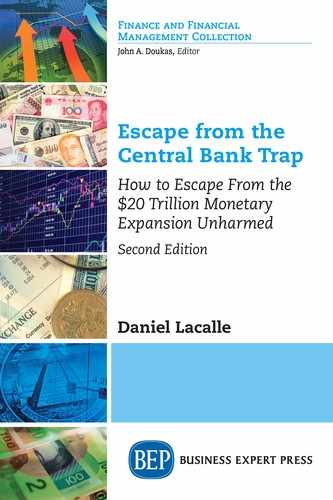Abenomics fails (Japan), 77–80
all-too-familiar bubble, 80–81
corporate structure, 86–87
demographic time bomb, 85
enormous debt, 82
justification, 83–85
Nikkei index, 82, 84, 85
velocity of money, 81
accumulated deficit, 33
all-time-high bubble, 51, 58–62
all-too-familiar bubble, 80–81
Argentina, inflation, 31–32, 185–190
asset purchase programs, 49
Australian currency, 194
Austrian school, 137
balance-sheet recession, 41, 43
Bank of International Settlement, 192
beggar-thy-neighbor policy, 135
Bretton Woods System, 43
brutal credit expansion, 7
Bush, George W., 191
Canadian dollar, 194
capital misallocation, 42
Central Bank of Ecuador (BCE), 36
central banks, 129–130
bonds, 51–52
Chinese problem, 40–42
constant regulatory changes, 147
credit growth, 146
debt, 24
Ecuadorians, 35–37
energy crisis, 133–135
European financial crisis, 147–150
eurozone crisis, 22
failure of, 139–142
financial assets, risk, 142–146
Fitch Ratings, 20
food and energy, 130–133
and governments, 150–152
interest rates, lower, 21, 144
liquidity trap, 19
MMT, 28–31
monetary and fiscal stimuli, 37–44
monetary tsunami, 129–130
money, printing, 35–37
money vs. inflation, 31–35
negative consequences, 22–24
oil burden, 130–131
overcapacity problem, 21, 40–41
pyromaniac fireman, 50–52
QE, 28–31
risks, 24–26
Russia, 135–137
Saudi Arabia vs. Venezuela, 133
wealth effect, 26–28
China, 191–196
central bank, 40–42
currencies, 192
dollar vs. yuan, 191–196
gold reserves, 192
mistake made by, 196
monetary imbalances, 195
money supply growth, 195
Treasury holdings, 193
U.S. dollar, 67–69
Choice in Currency, 196
commodities, 119–121
boom and bubble, 123–127
Chinese interests, 125–126
Federal Reserve, 122
financial crises, 124
financial markets, 120
oil prices, 121–122
U.S. dollar, 126
Commodity Research Bureau (CRB), 49
Consumer Price Index (CPI), 17, 177
Continuous Commodity Index (CCI), 123
credibility-enhancing communication, 142
Credit Default Swaps (CDS), 93
cryptocurrencies, advance of, 195–196
currency debasement, 190
debt, 45–47
all-time-high bubble, 58–62
corporate profit expectations, 53–57
emerging markets asset prices, 57–58
financial repression, 47–52
monetization, 101–102
positive effects, 52–53
QE, 58–60
Zombification, economy, 108–111
Denationalisation of Money, 196
destructive debt, 109
domino effect, 185
Draghi, M.
CDS, 93
debt monetization, 101–102
ECB, 3, 95–96, 99–100
EU, capacity utilization in, 89
eurozone sovereign crisis, 92–94
financial crisis, 91–92
Greece’s problem, 96–98
increase rates, 91
perverse incentives, 100–101
Spanish economy, 98
stock and flow, 102–103
targeted liquidity programs (TLTRO), 22–25
Trichet, J.-C., 90–91
earnings-per-share (EPS), 53–54
economics, 62, 124, 125, 143
Ecuadorians, central bank, 35–37
emerging markets, 63–67
asset prices, 57–60
CRB, 49
economic growth and stability, 64–66
monetary laughing gas, 38
overcapacity, 41
Trump, D., 70–75
U.S. dollar, 67–70
employment, temporary, 12
equity risk premium, 114
Europe, risk of, 190
European Central Bank (ECB), 95–96, 99–100, 161
expansive monetary policies
central bank, 160–161
ECB, 161
expansionary fiscal policy, 161
financial repression and QEs, 158–159
foolproof way, 162
Great Depression, 154–158
NIRA, 155
stock market, 159
supply-side policies, 163–169
Taylor rule, 163
zero nominal interest rate, 161–162
expansive policies, 73
federal funds rate, 6
Federal Reserve, 48, 50, 59, 73, 74, 186, 196
financial crisis, 5, 91, 124, 129, 147, 158
fiscal deficits, 188
financial repression, 41, 42, 47–52
fiscal policy, 161, 186
Fitch Ratings, 20
gradualism, 186
household debt, 7
Icahn, C. (investors), 75
Industrial Production, 177
inequality, 28, 158–160
“inflation-linked” assets, 185
inflation-linked bonds (ILBs), 173–174
interest rates, 6
investment-to-savings ratio, 115
investors
assets, 48–49
bonds, 172–174
central bank trap, 182–183
confidence, 51
equities, 174–179
Free Cash Flow Yield, 175
gold and bitcoin, 179–182
ILB, 173–174
risk, 171–172
Japan (Abenomics fails), 77–80
all-too-familiar bubble, 80–81
corporate structure, 86–87
demographic time bomb, 85
enormous debt, 82
justification, 83–85
Nikkei index, 82, 84, 85
velocity of money, 81
Keiretsu, corporate structure, 86
Keynesianism, 15, 69, 82, 116, 137, 184
Keynes, M. (monetary policy), 153
Kuznets, S. (Abenomics fails), 77
Lagarde, C. (IMF), 8
liquidity trap, 19, 50
Loans, Turkey’s, 189
market trade, financial repression, 47–52
McCullough, K.
commodities, 123
economic cycles, 175–176
modern monetary theory (MMT), 28–31, 187–188
monetary imbalances, 195
monetary policy, 3, 23, 31, 39, 40, 43, 46, 54, 61, 95, 105, 136, 140, 150, 151, 158, 163, 167, 186
monetary sovereignty, 186, 188
money
function, 29
printing, 3
velocity of, 20
vs. inflation, 30–35
money supply, 189, 195
mortgage-backed security issuances, 6, 7
mutual funds, 51
Nabiullina, E. (central bank), 135–137
National Industrial Recovery Act (NIRA), 155
National Trade Estimate Report on Foreign Trade Barriers (2017), 191
Nikkei index, 82, 84, 85
nuclear option, 191
Obama, B.,
administration, 191
fed balance sheet vs. interest rates, 11
out-of-control inflation, 101
pension funds, 51
policy making, course of, 18
productive investment, 115
pyromaniac fireman, Central Bank, 50–52
quantitative easing (QE), 8–13, 19, 20, 22, 28–31, 34, 44–62, 99–100, 159, 180, 183
quantitative tightening (QT), 185
record-high commodities prices, 125
Republican Party demands, 75
Retail Price Index (RPI), 173
return on invested capital (ROIC), 113
Rogoff, K. (QE), 9
Romer, P. (World Bank), 56
Roosevelt, F.D. (Great Depression), 154, 156
Rousseff, D. (Brazil), 57
Russia, central banks, 135–137
Shiller PE ratio, 51
Slok, T. (Federal Reserve), 74
supply-side policies, 69, 87, 116, 151, 163–169, 184
Swiss Franc, 194
Targeted Long-Term Refinancing Operations (TLTRO), 23
taxation, 97, 111, 160, 165, 184
Taylor Rule, 74
threshold of debt saturation, 109
trade deficits, 186
transmission mechanism problem,
95
Treasury holdings, 191, 193
Troubled Asset Relief Program (TARP), 10, 23
Trump, D., 28, 70–75, 160
Turkey, 185–190
US dollar, China’s efforts to dethrone, 191–196
vacuum effect, 67
volatile cost of debt, 109
Von Hayek, F.A., 196
wealth effect, 26–28
weighted average cost of capital (WACC), 113
welfare system, 80, 83, 86, 98
World Trade Organization, 191
yuan, dollar vs., 191–196
yuan devaluation, 192
Zaibatsu, corporate structure, 86
zero interest rate policy, 49
Zombification, economy, 105–106
cost of capital, 113–116
currency war, 106–108
debt, 108–111
eurozone, 105, 106
jobs, technology, 111
monetary policy mistakes, 105
tax burden, 111–113
